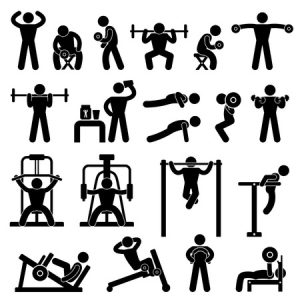
What if personal trainers could workout with each other more often? That would be fun! Enter in to my fitness training mind as I walk you through the way I think about my personal fitness, which trickles over to how I train clients.
A few years ago, one of my coaches told me, “Bodybuilding is a solo sport”. Truer words were never spoken, as I have discovered through my journey on this path. Please notice how the coach did not use the words “lonely sport”, because serious weight training is anything but lonely. Yes, readers, there is a difference!
When I train, I do it alone. 5 or 6 days a week, I enter the gym with an agenda. When I wake up in the morning, I know exactly which body parts I will be training. Not being dependent upon another individual to accomplish the task that lies before me is extremely comforting. This means that nobody else’s schedule can effect my dedicated workout time. I am fiercely protective of this hour, and use it to my best advantage.
Finding What Works
During my competitive bodybuilding years, I had a few tricks up my sleeve to facilitate rigorous training, enabling me to fight through fatigue and pain. Mental visualization is one of the most important keys to success in the gym; it ranks right up there with proper nutrition and the timing of re-fueling.
At some point prior to a workout, usually en route to the gym or the night before, I picture myself accomplishing what I know will be the most challenging exercise of the day. I see the success in my mind’s eye, breaking through any ceiling that might have previously blocked my progress. By the time I actually engage in the exercise, I am confident, prepared, and able to view it as a task I have already accomplished. Such mental visualization has thus become a “dress rehearsal”, as it were, for the real event. This process leaves little to no room for failure.
As competitions would approach, another trick that served me well was to imagine how at that precise moment in time, the athlete who will be on stage next to me is training harder than I am. This thought process kicked me into overdrive, igniting my desire to win and to work through plateaus.
As you can see, being inside my head with these thoughts eradicates any notion of weight training as being lonely. I am filled with purposeful resolve, and feel confident knowing that the visualizations and mantras are keeping me company throughout my workout.
Change Is Good
Since I believe in never allowing adaptation to slow me down, I change my workouts every 4-5 weeks. This process is akin to the routine maintenance we perform on our vehicles. An oil and air filter change keeps an engine running optimally; similarly, varying a workout will keep the muscles guessing, challenged, and growing. In addition to selecting different exercises for each body part, I also employ different weight/rep programs.
Some workouts favor lighter weights and higher repetitions, where other weeks focus on an inverted pyramid, super-sets, drop sets, and fewer reps of heavier weight loads. In this fashion, by the end of 6 months or so, my body will have been subjected to a constant stream of new stimuli. It cannot help but respond positively, again provided the appropriate fuel is available and consumed at the right times.
As a personal trainer, solo training may seem like a foreign concept. After all, if my clients chose this approach, I would be out of business! However, I vary my clients’ workout routines every 4-5 weeks too, so that they can reap the same benefits of muscle growth and conditioning as I strive for in my own lifting. After all, why keep such knowledge a secret? Their successes become my positive reinforcement, a win-win scenario. Clients enjoy knowing they are doing a version of what their trainer does on her own time. If that can help clients through a plateau, it is a success for all parties involved.
Choosing An Exercise
As for individual exercises, I generally rely on old-school moves: dumbbell and barbell curls, chest presses on flat, incline, and decline benches, squats, straight-leg deadlifts, weighted dips, rows, and hamstring curls. Aside from tweaking positioning — for example, hammer curls in place of regular bicep curls, or close-grip barbell curls to complement wide-grip barbell curls —- I prefer not to do anything too “fancy”. Risk of injury creeps up when we try to accomplish too many feats at once, such as performing a military press while balancing single-legged on a BOSU! Simply changing up the workouts every month safely alleviates any possibility of boredom.
Above all, select workouts that appeal to you and that drive you to be your best. Remember, there is a difference between being THE best and being YOUR best. The second option is always my goal!
[info type=”facebook”]What method(s) of training have proven to be the most successful for you? If you’re an NFPT trainer, join the Facebook Community Group to share with others and if you’re not, come chat with NFPT here![/info]
Cathleen Kronemer is an NFPT CEC writer and a member of the NFPT Certification Council Board. Cathleen is an AFAA-Certified Group Exercise Instructor, NSCA-Certified Personal Trainer, ACE-Certified Health Coach, former competitive bodybuilder and freelance writer. She is employed at the Jewish Community Center in St. Louis, MO. Cathleen has been involved in the fitness industry for over three decades. Feel free to contact her at trainhard@kronemer.com. She welcomes your feedback and your comments!

